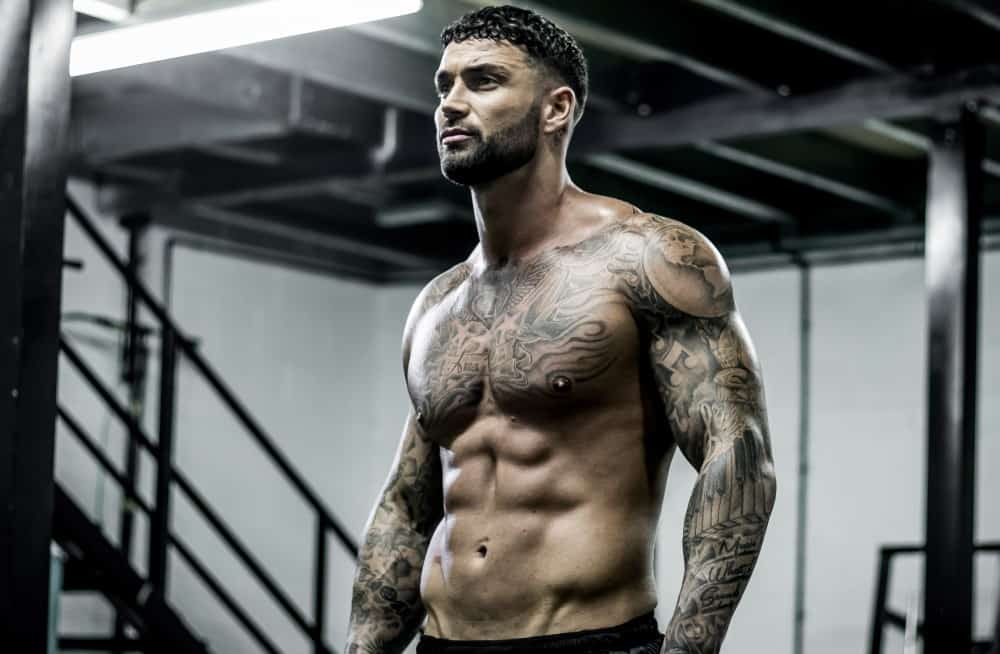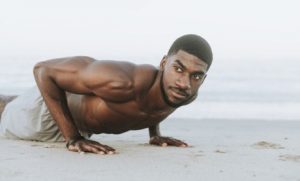After we have covered the most important basics about the optimal volume for hypertrophy, we’re now going more in-depth into each muscle group separately.
If you haven’t read the aforementioned article yet, definitely check it out if you still have any questions concerning the volume parameters.
Alright, so what can you expect from this article series?
Well, based on Dr. Mike Israetel’s expertise, as well as our own experience, we want to clarify the optimal volume for hypertrophy for each muscle group.

Now, some of you may think… doesn’t all muscles work and react similarly?
Well, yes and no.
To some extent, they might do, but because there are quite large differences, you should know all the important facts to adjust your workout over time.
Furthermore, this series about hypertrophy shall serve as the basis that you can use to bring your workout to the next level and start composing your own routine.
But let’s stop talking too much and get started on our journey to discover the optimal chest volume!
When I remember the time I started going to the gym, on the hand I am amused but on the other hand I wish I would have had the same knowledge about training I have today.
Wrong technique, too much volume and no muscle mind connection at all.
These are average mistakes that almost everybody makes somewhen in their career.
But eventually, it was necessary and important to make these mistakes in order to figure out what works and what doesn’t for my body.
It helped me understand how the muscles respond and work with forces, and how to train effectively.
At this point, I can only emphasize the importance that you learn and dig deep into all aspects of strength training.
In our age, we’re just a click away from tons of information about any problem.
So, what is your excuse wasting time in the gym because you’re doing the wrong exercises, executing the right exercises wrong and probably not even thinking about the logic of your workout schedule?
With this in mind, the purpose of this article series is to provide you with all the important and essential parameters that you need to be aware of when tailoring your own optimal hypertrophy volume program!
To begin with, it is important to consider the least amount of volume that you need to maintain your muscles.
MV – Maintenance volume
In this case, MV stands for “Maintenance Volume“, to put it in other words, the minimum amount of work that is required to maintain your muscles current size.
This is important to know because if you have to fall back or reduce your workouts for some time, you don’t want to lose your hard acquired gains, do you?
So then, what is the MV for chest?
MV: 8 sets/week
Approximately 8 sets each week are said to be sufficient in order to maintain your current chest’s size.
Of course, this can and does vary individually.
Some of you might need more volume whereas others need less volume to maintain their chest size, though.
Therefore, it is important to take these recommendations as benchmarks and not as fixed values.
Over time you’ll figure out what works best for you and what doesn’t. From that point on you adjust your workout according to your own body’s preferences.
MEV – Minimum Effective Volume
After we covered the MV (Maintenance Volume) compulsory for muscle maintenance, apparently we want to know the amount of volume to build muscles, right?
For that, we need the Minimum Effective Volume (MEV) which refers to the amount of volume that stimulates at least some growth.

What is recommended for the MEV?
MEV: 10+ sets/week
In general, we can say that around 10+ sets per week will work for most people, but again these are only average figures and can vary individually!
So, if you’re currently doing less than 10 heavy sets per week for your chest, that probably isn’t going to result in effective muscle growth.
But, if you’re working with 10 or more sets each week, this seems to be a good starting point for your optimal chest volume.
Asses your routine over time and adjust it according to your body’s responses.
MAV – Maximum Adaptive Volume
Now as we’ve figured out the MEV, the minimum growth stimulus, we surely want to know what’s the most effective volume.
Where can we set the MAV?
MAV: 12-22 sets/week
Here an average of 12-22 sets a week works out fine for most individuals. For instance, currently, my workout routine consists of around 22-24 sets each week and so far it feels good without getting sore too badly.
So again, you can see that there is no blunt right or wrong.
Working out isn’t just black or white as a lot of people think, there are so many variables (for more information check out our complete guide about the optimal volume for hypertrophy) that correlate with our performance and need to be considered when talking about the optimal chest volume.
MRV – Maximum Recoverable Volume
Last but not least we need to address the Maximum Recoverable Volume which reveals how much work can be done at max and still be able to recover from it properly.
This is crucial to know when compiling the optimal chest volume workout plan!
MRV: 20-22sets/ week
Most individuals seem to be able to recover from 20-22 sets each week and thus keep up consistent stimuli to grow their muscles.
Accordingly, a good point of reference for you lies around 20-22 sets per week.
Since the chest is a relatively big muscle, it can sustain and also needs heavier forces.
If you compare your chest with smaller muscle groups like biceps, of course, you don’t nearly need a volume of 20 sets per week to stimulate growth.
After we covered benchmarks for each volume parameter, we’ll consider other important variables.

Frequency
How often should you train your chest for the optimal chest volume?
2-3 times/week
Generally speaking, a frequency of 2-3 workouts/week in which your chest is exercised heavy works best for most people.
I would not recommend going higher than 3 workouts/week as the chest is a big muscle that takes a lot of damage and likewise needs its time to recover.
Therefore, 4 overloading workouts/week just tends to be too much.
People who have a big chest and lift very heavy can go with around 1.5 workout/week.
What does 1.5 workouts/week mean?
For example, your first workout is a really heavy one while your second workout will be lighter with maybe around 4 sets. This will help to keep your recovery up but still hit your chest to some extent and contribute to your volume.
Intensity
In general, it seems that super high reps ranges do not work that well for the chest. Most people benefit from a quite low rep range between 5-8 for the optimal chest volume.
As a max I would not recommend going higher than 12 reps, rather stay lower.
In general somewhere between 5-12 reps works out fine for most individuals.
Overall, the chest is composed of a high percentage of fast-twitch muscle fibers that are really responsive to high forces which is one of the reasons why benching relatively heavy works so well (if done properly).
Chest workout – exercises
When talking about the optimal chest volume, of course, we need to consider the actual chest workout.
Here we can identify three types of chest exercises:
Horizontal/flat pressing movements:
- Flat Barbell Bench Press
- Flat Dumbell Bench Press
- Flat Machine Bench Press
- Pushup
An important variable that you can adjust here is the width of your grip. Some people tend to have a wider grip whereas others prefer to have it closer.
Be aware that the wider or closer your grip is, the more/less triceps or chest involvement is deployed!
For example, close grip bench grip focuses way more on the triceps as compared to conventional bench press. However, wide grip bench press/push ups strain the chest muscle fibers more than the triceps.
So as you can see, there is no right or wrong, it simply comes down to your goal and personal preference.
Incline pressing movements:
- Incline Barbell Bench Press
- Incline Dumbell Bench Press
- Incline Machine Bench Press
- Incline Pushup
When using incline chest exercises, the most usual adjustment variable is the angle of the bench you’re using.
Some people prefer to use a relatively high angle with around 60-70° degree.
Personally, I am used to an angle around a 30-45°. But here again, this is my personal experience.
I would recommend you to try out different angles and see what suits your chest the best.
Isolation movements:
- Flat Dumbell Flys
- Incline Dumbell Flys
- Cable Flys
- Machine Chest Flys
- Machine Chest Butterfly / Pec Dec Fly
Isolation movements are great when it comes to the end of your workout, with lighter weights you can “finish” your muscles and get the beloved pump. But isolation movements are not solely great when it comes to the end of the workout. They have its right to exist and bring about great benefits.
You can also use them to pre-exhaust your muscle before starting with heavy bench press or other compound exercises in general. This will already give you a better feeling in your chest before starting off with the heavy exercises.
A lot of athletes who have issues with their mind-muscle connection will benefit from that because it facilitates them to properly feel their chest during heavy exercises.
Eventually, it is advisable to include all three types of chest exercises into your workout program. That does not necessarily mean that you have to do them all in one workout, you can split them over the week.
For instance, if you’re doing three chest workouts each week, the first one you’re prioritizing horizontal/flat exercises, the second one focusses on incline exercises and to finish off your week you could either combine all three or just do a light workout with only some isolation exercises and stir up the recovery.
Range of motion
Honestly, guys, throw your ego out of the door and go with the full range of motion.
But does that mean I should lift light?
Certainly not, you should lift heavy but only with forces that you can fully control.
If you want to get a big chest I would really recommend you to use the full range of motion of your chest for best results.
For some, this might mean to considerably reduce their weights, but I assure you, it’s worth it!
Your chest will get a better stretch and is even exposed to heavier forces as the toughest point is when the barbell touches your chest and you’re pushing it up from ground zero.
Furthermore, it is important to know that your chest works in two ways. Pushing movements and flying movements. The first consist of all bench press variations in different angles and the second refers to e.g. cable flys, machine butterfly or any other sort of fly variation.
Summing up:
You should lift heavy BUT only weights that you can control
Use the full range of motion
Perform both pushing and flying movements
Conclusion
What should you remember for the optimal chest volume?

Exercises: horizontal, flat, incline and isolation movements. I recommend you to include all three types of exercises in your workouts during the week.
Range of motion: throw your ego out of the door and use the full range of motion.
Practical tips
Supersets: isolation + compound press or vice versa
A good technique to save time during your workout and get a great pump.
You can start with the isolation movement for a couple of reps and directly afterwards you’re going to a pre-loaded bench and do a set of bench press.
Because you already hit your chest with the isolation movement, your chest is more likely to be the limiting factor and not your triceps or shoulders.
The other way around works as well. Means you start with a heavy compound press (flat or incline bench press) and again directly after your set is done you do an isolation movement for another couple of reps.
This will leave you with a bit more power in your first exercise and then give you a great way to finish your chest.
If you want to know more about supersets, follow the highlighted link to read a separate guide that I wrote on that topic.
Special shout-out to Dr. Mike Israetel, we really value his knowledge and the content that he shares with you guys on his YT channel and his blog.
Definitely check out his video about chest volume!
Furthermore, if you’re still looking for more awesome content, we can also recommend you to visit his blog.
I hope this article answered all your questions about the optimal chest volume for best results.
If you still have further questions, please leave a comment below and get in touch with us on our social media channels. We’re pleased to answer your question!
So, guys, I am curious.
How does your current chest workout volume looks like?
Cheers,
Claas





2 thoughts on “The Optimal Chest Volume – Hypertrophy Guide”
hi
It was great
I suggest Everyone read
Thanks a lot!